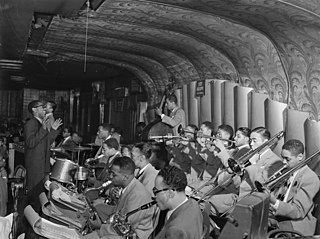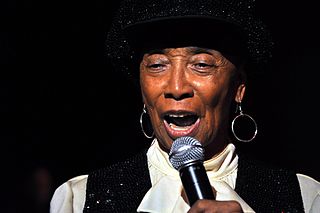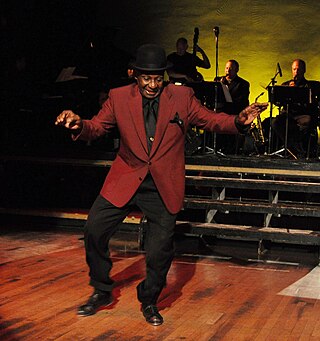Related Research Articles

The Savoy Ballroom was a large ballroom for music and public dancing located at 596 Lenox Avenue, between 140th and 141st Streets in the Harlem neighborhood of Manhattan, New York City. Lenox Avenue was the main thoroughfare through upper Harlem. Poet Langston Hughes calls it the "Heartbeat of Harlem" in Juke Box Love Song, and he set his work "Lenox Avenue: Midnight" on the legendary street. The Savoy was one of many Harlem hot spots along Lenox, but it was the one to be called the "World's Finest Ballroom". It was in operation from March 12, 1926, to July 10, 1958, and as Barbara Englebrecht writes in her article "Swinging at the Savoy", it was "a building, a geographic place, a ballroom, and the 'soul' of a neighborhood". It was opened and owned by white entrepreneur Jay Faggen and Jewish businessman Moe Gale. It was managed by African-American businessman and civic leader Charles Buchanan. Buchanan, who was born in the British West Indies, sought to run a "luxury ballroom to accommodate the many thousands who wished to dance in an atmosphere of tasteful refinement, rather than in the small stuffy halls and the foul smelling, smoke laden cellar nightclubs ..."
An Aerial is a dance move in Lindy Hop or Boogie Woogie where one's feet leave the floor. As opposed to a lift, aerial is a step where a partner needs to be thrown into the air and then landed in time with the music. Each aerial consists of a preparation ('prep'), jump or trick itself and the landing.

Swing dance is a group of social dances that developed with the swing style of jazz music in the 1920s–1940s, with the origins of each dance predating the popular "swing era". Hundreds of styles of swing dancing were developed; those that have survived beyond that era include Charleston, Balboa, Lindy Hop, and Collegiate Shag. Today, the best-known of these dances is the Lindy Hop, which originated in Harlem in the early 1930s. While the majority of swing dances began in African-American communities as vernacular African-American dances, some influenced swing-era dances, like Balboa, developed outside of these communities.
Swing music is a style of jazz that developed in the United States during the late 1920s and early '30s. It became nationally popular from the mid-1930s. The name derived from its emphasis on the off-beat, or nominally weaker beat. Swing bands usually featured soloists who would improvise on the melody over the arrangement. The danceable swing style of big bands and bandleaders such as Benny Goodman was the dominant form of American popular music from 1935 to 1946, known as the swing era, when people were dancing the Lindy Hop. The verb "to swing" is also used as a term of praise for playing that has a strong groove or drive. Musicians of the swing era include Duke Ellington, Benny Goodman, Count Basie, Cab Calloway, Jimmy Dorsey, Tommy Dorsey, Woody Herman, Harry James, Lionel Hampton, Glenn Miller, Artie Shaw, Jimmie Lunceford, and Django Reinhardt.

The Shim Sham Shimmy,Shim Sham or just Sham originally is a particular tap dance routine and is regarded as tap dance's national anthem. For today's swing dancers, it is a line dance.
The Big Apple is both a partner dance and a circle dance that originated in the Afro-American community of the United States in the beginning of the 20th century.

Jitterbug is a generalized term used to describe swing dancing. It is often synonymous with the lindy hop dance but might include elements of the jive, east coast swing, collegiate shag, charleston, balboa and other swing dances.

Frank Manning was an American dancer, instructor, and choreographer. Manning is considered one of the founders of Lindy Hop, an energetic form of the jazz dance style known as swing.

The Hot Shots is a collective name for two closely related Swedish dance companies based in Stockholm, Sweden: The Rhythm Hot Shots and the Harlem Hot Shots. The Hot Shots specialize in faithful reproductions of African-American dance scenes in American films from the 1920s, 30s, and 40s. Dances that they perform include Lindy Hop, Tap dance, Cakewalk, Charleston, and Black Bottom. The members of the Hot Shots are also respected dance instructors and accomplished social dancers. The goals of The Rhythm Hot Shots and the Harlem Hot Shots are the same.
Dean Collins was an American dancer, instructor, choreographer, and innovator of swing dance. He is often credited with bringing the Lindy Hop from New York to southern California. Collins worked in over thirty films and performed live and on television.
Al Minns, was a prominent American Lindy Hop and jazz dancer. Most famous for his film and stage performances in the 1930s and 1940s with the Harlem-based Whitey's Lindy Hoppers, Minns worked throughout his life to promote the dances that he and his cohorts helped to pioneer at New York's Savoy Ballroom. In 1938, Al Minns and Sandra Gibson won the Harvest Moon Ball.

The history of Lindy Hop begins in the African American communities of Harlem, New York during the late 1920s in conjunction with swing jazz. Lindy Hop is closely related to earlier African American vernacular dances but quickly gained its own fame through dancers in films, performances, competitions, and professional dance troupes. It became especially popular in the 1930s with the upsurge of aerials. The popularity of Lindy Hop declined after World War II, and it converted to other forms of dancing, but it never disappeared during the decades between the 1940s and the 1980s until European and American dancers revived it starting from the beginning of the 1980s.

Norma Adele Miller was an American Lindy hop dancer, choreographer, actress, author, and comedian known as the "Queen of Swing".

Herräng Dance Camp is the largest annual dance camp that focuses on Lindy Hop, boogie woogie, Tap dance, jazz dance, and balboa. It is held for 5 weeks annually from late June through July in Herräng, Sweden and focuses both on instruction and dancing.
"Jumpin' at the Woodside" is a song first recorded in 1938 by the Count Basie Orchestra, and considered one of the band's signature tunes. When first released it reached number 11 on the Billboard charts and remained on them for four weeks. Since then, it has become a frequently recorded jazz standard.
Al & Leon were a prominent American Lindy Hop and jazz dance duo. The two members were Al Minns and Leon James. They were most famous for their film and stage performances in the 1930s and 1940s both on their own, and as part of the Harlem-based Whitey's Lindy Hoppers. They appeared in the Marx Brothers film A Day at the Races. They also appeared on US television programs in the 1950s and 1960s, highlighting the jazz dances they and their cohorts helped to pioneer at the Savoy Ballroom in New York, as well as working throughout their lives to promote the dances to new generations.

Charles "Chazz" Young is an American choreographer and teacher of tap dance.

The Lindy Hop is an American dance which was born in the African-American communities of Harlem, New York City, in 1928 and has evolved since then. It was very popular during the swing era of the late 1930s and early 1940s. Lindy is a fusion of many dances that preceded it or were popular during its development but is mainly based on jazz, tap, breakaway, and Charleston. It is frequently described as a jazz dance and is a member of the swing dance family.
Leon James was a prominent American Lindy Hop and jazz dancer. A performer during the 1930s and 1940s with the Harlem-based Whitey's Lindy Hoppers, he and his dance partner Willa Mae Ricker were featured in a photo essay in the August 23, 1943, issue of Life magazine, demonstrating air steps.
Willa Mae Ricker was a prominent American Lindy Hop and jazz dancer and performer during the 1930s and 1940s with the Harlem-based Whitey's Lindy Hoppers. She was known for her physical strength, fashion sense, dependability, business acumen, and passion to dance. According to Norma Miller, Ricker was the first dancer to stand up to Herbert "Whitey" White, demanding fair pay.
References
- 1 2 3 4 5 6 7 Manning, Frankie; Millman, Cynthia (2007). Frankie Manning: Ambassador of Lindy Hop. Philadelphia: Temple University Press. ISBN 978-1-59213-563-9.
- 1 2 Sago, Renata (August 10, 2018). "From Harlem to Herrang: An Original Lindy Hopper Blooms in Sweden". The New York Times .
- 1 2 3 4 "Norma Miller: National Visionary". National Leadership Visionary Project. 2013.
- ↑ "A Day at the Races". Library of Congress. Retrieved July 24, 2020.
- 1 2 3 4 McFadden, Robert D. (May 6, 2019). "Norma Miller, Lindy-Hopping 'Queen of Swing,' Is Dead at 99". The New York Times .
- ↑ Sago, Renata (October 1, 2015). "At 95 Years Old, Norma Miller, the Queen of Swing, Still Reigns". WGCU (TV) .
- ↑ "'Alive And Kicking' Chronicles Deep History Of Swing Dancing". NPR . April 9, 2017.
- ↑ THIRTEEN Specials | Frankie Manning: Never Stop Swinging | PBS , retrieved 2023-05-25
- ↑ Stevens, Tamara (2011). Swing dancing. The American dance floor. Santa Barbara, Ca.: Greenwood. p. 84. ISBN 978-0-313-37517-0.
- ↑ rikomatic (2020-08-26). "Watch Jimmy Valentine, a Legendary One-legged Lindy Hopper, Throwing Down with Sylvia Sykes". Yehoodi. Retrieved 2023-05-25.
- ↑ The Soundies Distributing Corporation of America: a history and filmography of their "jukebox" musical films of the 1940s. Terenzio, MacGillivary, Okuda. 1954. page 72. ISBN 0-89950-578-3
- ↑ The Soundies Distributing Corporation of America: a history and filmography of their "jukebox" musical films of the 1940s. Terenzio, MacGillivary, Okuda. 1954. page 96. ISBN 0-89950-578-3